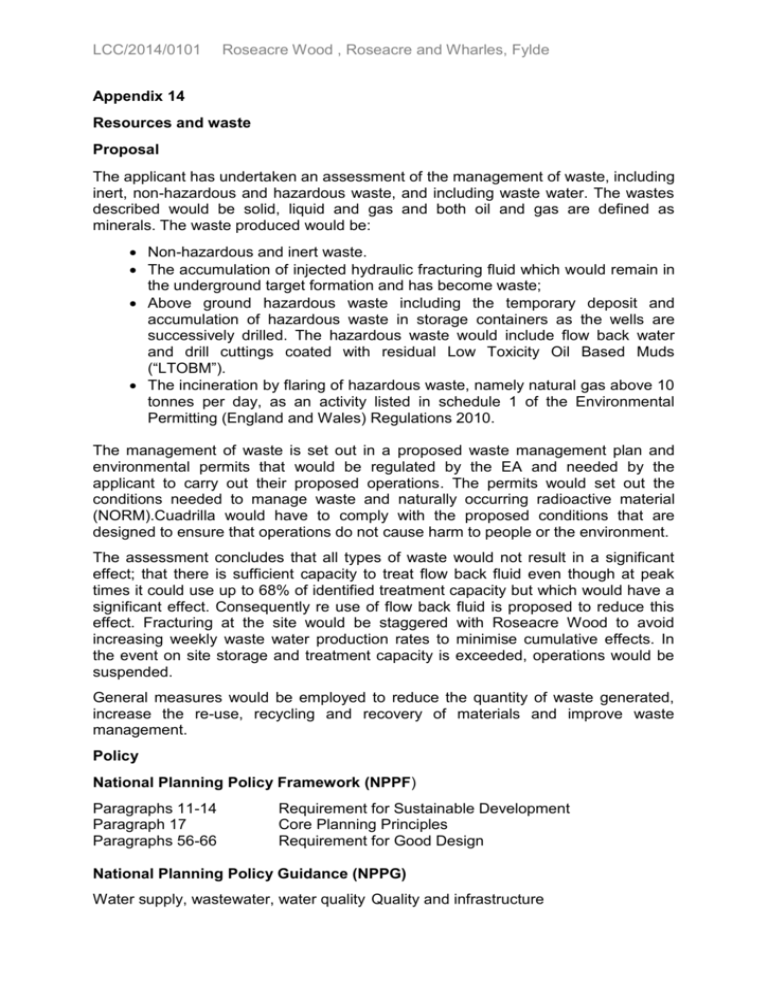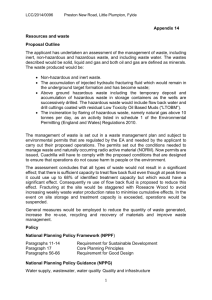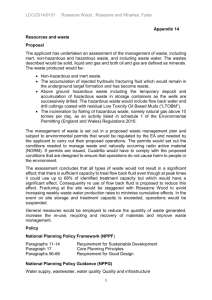LCC/2014/0101 Roseacre Wood , Roseacre and Wharles, Fylde
advertisement

LCC/2014/0101 Roseacre Wood , Roseacre and Wharles, Fylde Appendix 14 Resources and waste Proposal The applicant has undertaken an assessment of the management of waste, including inert, non-hazardous and hazardous waste, and including waste water. The wastes described would be solid, liquid and gas and both oil and gas are defined as minerals. The waste produced would be: Non-hazardous and inert waste. The accumulation of injected hydraulic fracturing fluid which would remain in the underground target formation and has become waste; Above ground hazardous waste including the temporary deposit and accumulation of hazardous waste in storage containers as the wells are successively drilled. The hazardous waste would include flow back water and drill cuttings coated with residual Low Toxicity Oil Based Muds (“LTOBM”). The incineration by flaring of hazardous waste, namely natural gas above 10 tonnes per day, as an activity listed in schedule 1 of the Environmental Permitting (England and Wales) Regulations 2010. The management of waste is set out in a proposed waste management plan and environmental permits that would be regulated by the EA and needed by the applicant to carry out their proposed operations. The permits would set out the conditions needed to manage waste and naturally occurring radioactive material (NORM).Cuadrilla would have to comply with the proposed conditions that are designed to ensure that operations do not cause harm to people or the environment. The assessment concludes that all types of waste would not result in a significant effect; that there is sufficient capacity to treat flow back fluid even though at peak times it could use up to 68% of identified treatment capacity but which would have a significant effect. Consequently re use of flow back fluid is proposed to reduce this effect. Fracturing at the site would be staggered with Roseacre Wood to avoid increasing weekly waste water production rates to minimise cumulative effects. In the event on site storage and treatment capacity is exceeded, operations would be suspended. General measures would be employed to reduce the quantity of waste generated, increase the re-use, recycling and recovery of materials and improve waste management. Policy National Planning Policy Framework (NPPF) Paragraphs 11-14 Paragraph 17 Paragraphs 56-66 Requirement for Sustainable Development Core Planning Principles Requirement for Good Design National Planning Policy Guidance (NPPG) Water supply, wastewater, water quality Quality and infrastructure LCC/2014/0101 Roseacre Wood , Roseacre and Wharles, Fylde Joint Lancashire Minerals and Waste Development Framework Core Strategy Development Plan documents (LMWDF) Policy CS1 Policy CS5 Safeguarding Lancashire's Mineral Resources Achieving Sustainable Minerals Production Joint Lancashire Minerals and Waste Local Plan – Site Allocation and Development Management Policies – Part One (LMWLP) Policy NPPF 1 Policy DM2 Presumption in favour of sustainable development Development Management Fylde Borough Local Plan Policy EP23 Policy EP24 Policy EP26 Pollution of Surface Water Pollution of Ground Water Air Pollution Summary of Consultee comments and representations LCC Director of Public Health: Has undertaken a Health Impact Assessment (HIA) on the two drill sites and identified that the key risks to health and wellbeing of the population from the two proposed sites are a lack of public trust and confidence in the regulatory process and the industry, stress and anxiety from uncertainty about the industry that could lead to poor mental wellbeing; potential noise related health effects due to continuous drilling for at least five months for the initial borehole on each site and for three months for each of the subsequent three boreholes per site (14 months of continuous drilling), and potential health risks due to the presence of mining wastes generated as part of the drilling and hydraulic fracturing process being retained on site if adequate off site treatment facilities are not found. As part of the recommendations it is recommended that: 11. Further clarification or new information on the occurrence and magnitude of equipment likely to be contaminated with radioactive waste and how such waste would be managed on the site and disposed of should be sought. 12. Should planning permission be granted, it should be a pre requisite that no activity can start until the onsite and offsite waste treatment capacity is defined. Medlar-with-Wesham Parish Council and Kirkham Town Council: Recommend the application should be refused for a number of reasons including the following specifically to resource and waste: Potential flow back water site leakages and spillage during disposal and transportation. No information on water treatment plans. Where will flow back water be treated and will any new treatment plan accept waste from other UK sites. LCC/2014/0101 Roseacre Wood , Roseacre and Wharles, Fylde Friends of the Earth (FOE): has objected to the proposal and further information for a number of reasons including waste. They have also commissioned consultants to advise on waste. The reasons for objecting are summarised as follows: Insufficient information on how overflow water and wastewater discharges, and pollutants, will affect the local environment and protected sites. Management of contaminated wastewater is wholly inadequate. There is a lack of treatment centres, resulting in potential capacity issues, especially if flow back rates are higher than estimated. This is not an adequate solution. Contrary to Planning Policy (Statement 10) as the application produces huge quantities of waste. It is unclear what waste quality standards would be applied by the applicant to ensure that concentration of pollutants in the wastewater did not accumulate beyond safe levels as a result of re-use for fracking and how risks to the environment and health and safety would be mitigated. Further investigation is required before the Council can lawfully grant an application to drill. Legacy of underground waste which will be present is denied, not a temporary development as it will create permanent contaminated wastewater Risks from flow back fluid and waste water. Risks of storage of waste to protected ecological areas. The applicant does not adequately take into account the possibility of higher flowback rates than forecast or competing demands, and how this will be dealt with. The steps to be taken that are outlined in the applicant’s response do not address where additional treatment capacity will come from. In support of this view FOE have commissioned waste expert Alan Watson to review the waste implications of the application. Roseacre Awareness Group: object to the proposal in respect of waste and resources for the following summarised reasons: Surface water drainage into Nigget Brook could contaminate Thistleton Brook which flows into River Wyre and Morecambe Bay. Accidental spillages from the site or vehicles could impact on water and land. with impacts on local wells used by livestock and groundwater contamination Storm impacts have not been taken into account, with risk of flooding. Insufficient evidence that fracking fluid will not leak into local water sources through existing faults. Flow back fluid estimates do not cover worst scenario. Wastewater treatment sites do not have capacity to treat all the flow back fluid, including radioactive waste resulting in storage concerns. Concern regarding content and quantity of chemicals in fracking fluid. Huge amounts of waste will be produced and could lead to significant traffic removing hazardous and toxic waste products. Applicant not demonstrated how they would reuse/recycle/treat flowback fluid. Concerns have been expressed in representations received objecting to the proposal relating to the production, management and transportation of waste and the location and capacity of waste management facilities. LCC/2014/0101 Roseacre Wood , Roseacre and Wharles, Fylde Creation of toxic wastewater. Each well will produce 2.5million gallons of flow back. Lack of information and research on how the massive amounts of waste water will be disposed of and treated. Inadequate measures are in place to treat and dispose of vast quantities of waste water. No adequate disposal solution has been presented There is no adequate treatment facilities that have insufficient capacity for huge volumes of hazardous and wastewater waste. Insufficient information in the Waste Management Plan regarding drill cuttings storage and disposal and dust implications. What will happen to flowback water and its treatment? No guarantee of safe disposal of chemical waste and drilling muds. Manchester Ship Canal cannot take anymore waste. Cuadrilla have dumped two million/thousands of gallons of radioactive/ contaminated waste water into Manchester Ship Canal (from Barton Moss) and were allowed to get away with it. The EA cannot guarantee that this will not happen again. Roseacre, Wharles and Treales Parish Council: Objects to the proposal for the following summarised reason: Flowback fluid calculations are disputed. Higher rates and no suitable disposal could result in risk of breach of the well pad containment area. Flowback predictions are wrong and therefore impact on storage, transport and waste. Flowback cannot be shut off. Assessment of impacts An assessment of the proposals has been carried out. With regard to inert, nonhazardous and hazardous waste associated with the construction, drilling, hydraulic fracturing, initial and extended flow testing and decommissioning it is considered that subject to compliance with the necessary permits issued by the EA the quantities generated would not result in a significant effect. The treatment of the quantity of waste water generated by the project would result in a significant effect and so mitigation to reduce this effect is proposed to include recycling of flow back water and staggering of operations. In particular there would be a requirement, wherever possible, to re-use the flow back fluid once the gas has been separated. This would reduce the amount of waste which needs to be disposed at an offsite facility. About 10-40% of the injected fluid is predicted to return to the surface. The applicant proposes to leave some fracture fluid deep underground. The EA is of the view that leaving some of the retained fluid in situ is the 'Best Available Technique'. The EA has assessed the components of the fluid to be used in fracking process and is satisfied that it is non-hazardous. They are also satisfied that the fluid that would be retained underground would be non-hazardous and that over time the retained fluid would become indistinguishable from the water already present in the target formation. LCC/2014/0101 Roseacre Wood , Roseacre and Wharles, Fylde Naturally occurring radioactive material (NORM) is present in many geological formations including oil and gas bearing strata such as shale formations. The flowback fluid that returns to the surface following hydraulic fracturing as well as the sediments and scales in gas or water process vessels, is likely to contain sufficient NORM that it will be classed as radioactive waste. The level of radioactivity is considered to be extremely low. The EA has assessed the impact and proposals for NORM disposal and is satisfied that the applicant has demonstrated that it can have suitable arrangements in place with licenced waste disposal companies for its treatment. Drill cuttings can be contaminated with hazardous waste. All hazardous waste must be stored in solid steel containers which are subject to inspections. The EA has advised that they are satisfied with the proposed arrangements. With regard to representations received, it is considered that waste can be acceptably contained and that there are available facilities with capacity to accommodate the waste to which safe purpose designed transport would deliver it. The permitting process would restrict the available storage on site and the continued production of such in the event off site facilities were unavailable. The site can be contained in a way to prevent discharge or over spill off site and provide secure storage facilities. The permitting process would apply the necessary controls on waste quality standards. There would be no risk of migration of fracking fluids that could result in cross contamination of water resources and leaving fluids in the ground would not result in contamination in their own right. The waste is not toxic and would not be stored close to residential properties or schools and the site would be secure preventing unauthorised access. Paragraph 122 of the NPPF requires that planning authorities should not seek to control processes or emissions were these are subject to approval under separate pollution control regimes and that LPA's should assume that these regimes will operate effectively. Nonetheless, paragraph 112 of PPG Minerals, notes that before granting permission the local planning authority should be satisfied that the issues dealt with under other regimes can be adequately addressed by taking advise from the relevant regulatory body'. The County Council has consulted with the EA and which has not objected. The EA has granted the environmental permits needed to carry out the proposed operations. The permits set out the conditions needed to manage waste and NORM.The applicant would have to follow the proposed conditions that are designed to ensure that operations do not cause harm to people or the environment. The EA is satisfied that the permit and associated conditions will require that extractive wastes are managed in a way that minimises harm to human health and the impact on the environment. The operator has demonstrated this through a waste management plan that accompanies the permit application. The EA is satisfied that the proposals are in line with the waste hierarchy. In their letter of 19th December, FOE attached a report by Alan Watson, Public Interest Consultants entitled “Review of the Waste Related Aspects of the Cuadrilla Lancashire Planning Applications”. The report commissioned by FOE concludes that the applicant does not adequately take into account the possibility of higher flowback LCC/2014/0101 Roseacre Wood , Roseacre and Wharles, Fylde rates than forecast or competing demands, and how this will be dealt with. The steps to be taken that are outlined in the applicant’s response do not address where additional treatment capacity will come from. The ES presents details of the usage of water for each of the different stages of the project. The daily demand figures allow the capacity of infrastructure to be assessed. The total water demand figure allows the impact on water resources to be assessed. The ES (chapter 17 and Appendix B) presents the flowback fluid production estimating that 40% of the total injected hydraulic fracturing fluid will return as flowback fluid during the initial flow testing phase. Appendix B reports on the proportion of this flowback fluid that will be reused to make up part of the fracturing fluid for the subsequent fracturing stage. The remaining flowback fluid produced would be stored temporarily on site before being tankered off site for treatment and disposal at a licenced wastewater treatment works. The rate at which flowback fluid would be removed from site for specialist treatment has been assessed using the maximum weekly volume produced by the Project. The peak weekly volume produced onsite has been compared to the baseline capacity at the specialist treatment facilities as detailed in section 17.6 of the ES. The storage capacity on site provides a buffering capacity to manage flowback production. The provided storage volume has been calculated to ensure that the rate of flowback fluid production does not exceed the weekly treatment capacity. Section 17.8.5.3 of the ES describes the steps Cuadrilla will take to manage flowback fluid to ensure that volumes of fluid removed from site for treatment will not exceed the available treatment capacity. In their Decision Document supporting the waste management permits, the EA have also addressed concerns regarding he availability of treatment capacity and state “We are satisfied that there is currently adequate capacity to treat and/or dispose of the waste generated by the permitted activity” (EA, Decision Document, Annex 1, B. This issue has been reviewed by the EA in their determination of the Mining Waste Permit and the EA was satisfied that Cuadrilla has used appropriate information to design the proposals and that there are sufficient controls in place to ensure that flowback is controlled, treated and disposed of appropriately. The Applicant will enter into contracts with treatment facilities if planning permission is granted and prior to fracturing operations commencing which shall ensure sufficient treatment capacity is available. Section 17.8.5.3 of the ES (Preston New Road ES paragraph 378 / Roseacre Wood ES paragraph 373) describes the steps Cuadrilla would take if higher flowback fluid production was experienced to ensure the quantity of flowback fluid requiring treatment does not exceed the available treatment capacity. These steps would comprise: Provision of additional on-site tank capacity to temporarily store flowback fluids so that off-site disposal does not exceed the treatment rate agreed with the relevant treatment works; Consideration of shutting off the well for a short period (i.e. temporary suspension of flowback production) to allow flows off-site to be controlled to within the available treatment capacity; and LCC/2014/0101 Roseacre Wood , Roseacre and Wharles, Fylde Consideration of amendments to hydraulic fracturing operations to reduce flowback volumes e.g. reduced number of hydraulic fracturing stages, smaller volumes etc. Conclusion Resource and waste issues have been assessed by the applicant. It is considered that the quantity of inert, non-hazardous and hazardous waste that would be generated along with the quantity of wastewater and industrial waste water would not result in a significant effect. The EA has been consulted and has advised on the regulatory regime that would be employed to manage the risks and that they are satisfied that that such risks could be managed in a way that would not cause any unacceptable impact. It is considered that the waste can be managed in an acceptable way. The County Council should assume that these regimes will operate effectively and can be satisfied that the issues dealt with under other regimes can be adequately addressed. The proposal could be acceptably controlled by other regulatory regimes and would not have any unacceptable impacts and would comply with national guidance and policies and the policies of the development plan.







![Lymphatic problems in Noonan syndrome Q[...]](http://s3.studylib.net/store/data/006913457_1-60bd539d3597312e3d11abf0a582d069-300x300.png)